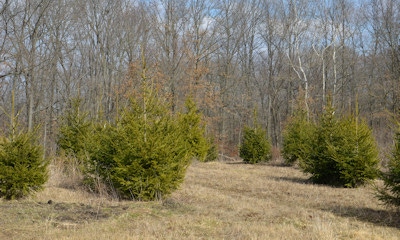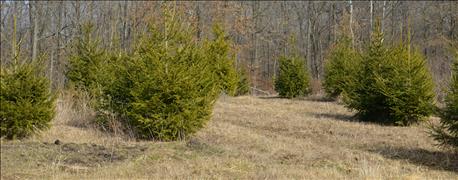
For some 30 years, Les Zimmerman has grown and sold trees wholesale to landscapers and contractors within a 150 mile radius of his farm near Clinton in Vermilion County. “When you’ve only got a 100-acre farm, you have to do something that is labor intensive to produce income,” he says. For him that meant developing a successful tree nursery.
The 2016 Indiana Association Soil and Water Conservation Districts 2016 Supervisor of the Year is phasing out his nursery and returning the land to cropland. “I don’t call it retiring,” he quips. “It’s just another phase of my life.”

READY FOR TRANSFORMATION: Once Les Zimmerman finishes selling off these cedar trees, this field will be converted to cropland. Note the large hole where a tree was dug in the bottom left corner. It takes a couple years to make the land level enough to move to no-till.
While he is still selling trees, a good portion of his land has already been cleared. A young farmer does the farming for him.
“We’re going to no-till, but you can’t just get there overnight after the land has been in a tree nursery for this long,” he says. When the trees are dug, holes are left behind. The holes have to be accounted for and the land leveled before it can be farmed successfully again. Yet Zimmerman believes they are on their way.
“We’re heading toward a rotation of corn, soybeans and wheat,” he says. Once he chisels it and gets it leveled back up enough that he can drive over it successfully, it’s going to no-till.
Cover crop strategy
Zimmerman has observed various farmers around the state use cover crops to improve soil health. He has been instrumental in starting and continuing to find funding for the Conservation Systems Tillage Initiative.
“We’re including wheat because when it comes off, we’re going in late summer with a cocktail mix of cover crops,” he says. “The idea is to produce nitrogen and capture nutrients, and improve soil health in general.”
Sowing cover crops after wheat will allow him to seed earlier in the summer without interseeding into standing corps. He believes it can help get a good start for the cover crops, which he believes are essential to improving soil health.”
More farmers are using cover crops and no-till because it pays, he says. “It’s the right thing to do as well. It will help build soil health back on this farm.”
About the Author(s)
You May Also Like




